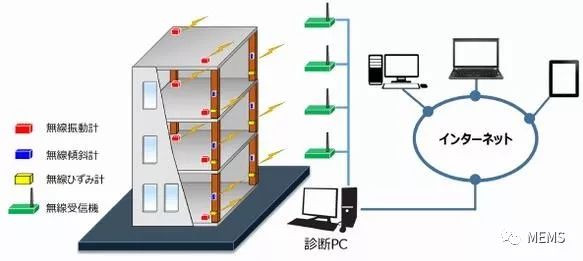According to a report by Mammus Consulting, Dacheng Construction Group of Japan recently announced that it has developed a building structure monitoring system in cooperation with Yokogawa, Nagano Japan Wireless Co., Ltd. and the University of Tokyo. Long-term structural stability monitoring can be achieved with newly developed high-precision MEMS (Micro Electro Mechanical Systems) sensors combined with wireless technology in the 920 MHz band.

Building structure monitoring system developed this time (Source: Japan Dacheng Construction Group)
Although the aging of social infrastructure such as bridges and buildings has become one of the important issues of concern to the Japanese government, the human resources and technology research and development required to maintain these infrastructure structures are rapidly being implemented in cooperation with industry, academia and government. . The system developed this time was developed as part of the NEDO (Japan New Energy Industry Technology Development Organization) commissioned project (social task system development project such as infrastructure maintenance and renewal). Yokogawa is a supplier of high-precision MEMS sensors. Nagano Japan Wireless Co., Ltd. is a wireless communication technology provider in the 920MHz band. Japan's Dacheng Construction Group and the University of Tokyo are responsible for building structural soundness assessment.
The newly developed MEMS sensor is used in the building structure monitoring system: the vibration sensor has a resolution of 1 mgal (Note: 1 gal = 1 cm/s^2), and the strain sensor has a resolution of 1 nm, which has a longer maintenance period than the conventional sensor. It is possible to accurately measure minute deformations and vibrations generated in the structure over a long period of time.
The monitoring data obtained from the MEMS sensor is transmitted in the 920 MHz band (nearly affected by structures such as walls and ceilings inside the building). The sensor data is collected into a receiving device installed on each floor and transmitted to a diagnostic computer (PC), thereby reducing the wiring work of the building structure. Moreover, in order to install a monitoring system where power cannot be used, an independent power supply unit is currently being developed.
In the diagnostic computer (PC), the building structure soundness assessment system "T-iAlert Structure" is operated. It analyzes the natural frequency, distortion and tilt angle of the structure based on the measurement data acquired by the MEMS sensor and monitors the structure over time for a long time. When an earthquake of magnitude 3 or higher occurs, a sound diagnosis is performed based on the vibration occurring in the structure of the building. When an abnormal condition is diagnosed, a diagnosis of the secondary injury site can be performed.
In 2018, Japan's Dacheng Construction Group will accumulate experimental experience in existing buildings and civil engineering structures, and propose building BCP (Business Continuity Plan) measures based on the analysis results of the system. From April 2019, Japan's Dacheng Construction Group hopes to fully implement the deployment of the system.
RandM Tornado 7000 Disposable Vape is a rechargeable and prefilled device so there is no requirement to change the coil or refill the e-liquid. It is ready to use so you can take it to your mouth and start enjoying delicious puffs. There are twenty-one flavours available in the RAndM Tornado 7000 Rechargeable Disposable Vape Device. You can have a refreshing and joyful vaping experience with all these flavours. The package is 10pcs per box. OEM order is welcome!
RandM Tornado 7000, RandM 7000 Puffs, RandM 7000 disposable
Shenzhen Kate Technology Co., Ltd. , https://www.katevape.com